Read Reviews
The Best Planer Thicknessers
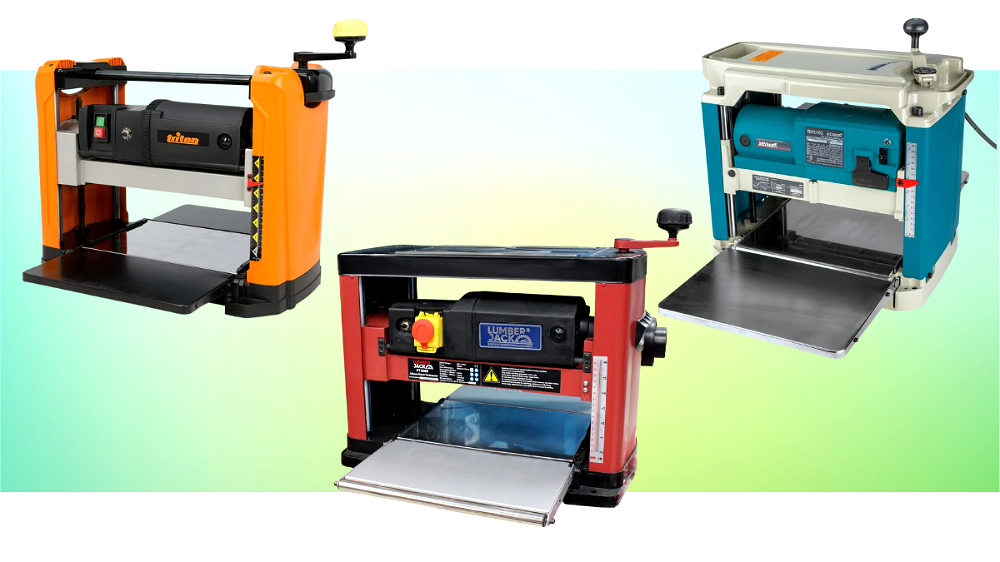
-
Best for quality and value - Triton TPT125 Thicknesser
-
Best for home workshop - Lumberjack PT330B Portable Bench Top Planer Thicknesser
-
Best for quality and portability - Makita 2012NB/2 Thicknesser
-
Best for large timbers - VEVOR 12.5 Inch Thicknesser Planer
-
Best for power - DeWalt DW733 230V Portable Thicknesser
-
Best with jointer feature - Scheppach HMS 80 Dressing and Thickness Planer
-
Best lightweight benchtop planer - Silverline 344944 Bench Planer
Planer Thicknesser Reviews
1. Triton TPT125 Thicknesser
Best for quality and value
- The price of this thicknesser puts it within the reach of more DIYers compared with the DeWalt or Makita machines. It’s almost as good, and almost half the price!
- You can use the roller bar on the top of this planer to pass wood over the top of the machine after planing. If you’re strapped for space, this can save you a lot of effort.
- Even though this is a less expensive benchtop planer, it comes well set up from the factory. You won’t need to spend hours fine tuning it to cut boards nice and flat.
- Compared with even the small benchtop planers on my list, this 1,100 Watt motor is underpowered. It will need to work harder to cut the same wood at a slower speed.
- Several users have complained about the noise this machine makes. Compared with the relatively quiet Makita machine, you’ll always need ear protection.
- The size of the infeed and outfeed tables are relatively small. To avoid planer snipe, you’ll need to extend these tables a bit more.
- Power
- 1,100W
- Cutter speed
- 8,750rpm
- Feed rate
- unknown
- Max planing width
- 317mm
- Max planing depth
- 2.4mm
- Max thickness
- 3.2-150mm
- Weight
- 28.3kg
- Build quality
- 4
- Performance
- 5
- Ease of use
- 5
- Value for money
- 5
The Triton TPT125 Thicknesser has an 1,100 Watt motor that provides 17,500 cuts per minute. The machine has a 317 mm cutting width and can cut wood up to 152 mm thick. It has large infeed and outfeed tables, a dust extraction chute and a circuit breaker for safety.
This thicknesser is one of the best small planer thicknessers for ease of use and quality of finishing. This finisher is a little slower than the DeWalt thicknesser, especially on hardwood, but it still gets through the timber pretty quickly. This machine is lighter than other tools in this guide but still feels robust.
The Triton planer thicknesser does the job well and is excellent value for money.
Did you find this review helpful?
2. Lumberjack PT330B Portable Bench Top Planer Thicknesser
Best for home workshop
- The infeed and outfeed tables have rollers built in to them. This makes the feed process much smoother and helps to avoid annoying planer snipe.
- It’s always good to see an emergency stop button on any big bit of workshop machinery. Being able to bang down on a big red stop button could save your work or even keep you safe.
- You can easily switch what side the dust port extracts on. Using just a pair of bolts, you’re not confined to just one side. It comes with a handy dust extractor adapter for different size vacuum hoses too.
- A thicknesser that weighs 35 kg is great for reducing vibration, but it’s pain to try and move around. The idea behind a benchtop thicknesser is to be portable, but this one isn’t!
- Some users have complained about the build quality of this planer. Parts are readily available and it’s easy to work on, but it’s not as well made compared with the Makita 2012NB/2.
- Even though double edged blades last for twice as long as single edged ones, the ones supplied can’t be re-sharpened. They’re not too expensive to replace at least.
- Power
- 1,500W
- Cutter speed
- 8,500rpm
- Feed rate
- 7.5m/min
- Max planing width
- 330mm
- Max planing depth
- 2.8mm
- Max thickness
- 152mm
- Weight
- 35kg
- Build quality
- 4
- Performance
- 4
- Ease of use
- 4
- Value for money
- 4
British tool company Lumberjack make some surprisingly good kit for DIYers. With everything from pillar drills to chainsaws to choose from, they’re fast becoming one of the more recognisable names out there. The 1,500 Watt PT330B benchtop planer thicknesser is an impressive machine.
This portable woodworking planer has a massive 330 mm cutting width, which is easily the biggest capacity for thicknessing on my list. With a maximum cut depth of 152 mm as well, you can fit some serious size pieces of wood in this machine.
The no-load speed of 8,500 rpm and maximum planing depth of 2.8 mm per pass is impressive for a benchtop planer. It means you can get a lot of work done without needing to make too many passes. The 7.5 m per minute feed rate isn’t too bad either.
What I really like about this hefty woodworking tool is how robust it is. Weighing 35 kg, it’s not a flimsy toy and everything feels well made. You can easily swap parts out, and they’re readily available including the double-edged blades.
Did you find this review helpful?
3. Makita 2012NB/2 Thicknesser[ SAVE 5% ]
Best for quality and portability
- One of the things you’re paying for in a premium machine like this is that it works perfectly, straight from the box. There’s minimal fine tuning needed to make it plane flat.
- The infeed speed of 8.5 m per minute is the best on my list. If you’ve got a lot of planing to do, you can gang up the work and do it much quicker compared with any other planer here.
- Dialling in a precise and specific thickness is easy using the adjustment wheel on top. It allows you to get to within a fraction of a millimetre, so it’s incredibly accurate.
- Some users have complained about planer snipe from this machine. Even though it has auto feed rollers, you need to keep some pressure on the wood at the end of a pass.
- You need to attach the dust hood to avoid getting buried in a pile of chippings. One of the downsides to having such a powerful machine is the amount of mess it can make.
- Even though it’s not as expensive compared with the DeWalt DW733, this is still not a tool for the casual DIYer. It’s a professional level tool that comes with the appropriate high price.
- Power
- 1,650W
- Cutter speed
- 8,500rpm
- Feed rate
- 8.5m/min
- Max planing width
- 304mm
- Max planing depth
- 3.0mm
- Max thickness
- 3-150mm
- Weight
- 27.0kg
- Build quality
- 5
- Performance
- 5
- Ease of use
- 5
- Value for money
- 4
The Makita 2012NB/2 Thicknesser has a 1,650-watt motor that delivers up to 8,500 rpm. It has a 304 mm cutting width and a 150 mm cutting depth.
This Makita planer thicknesser is one of the best thickness planers around. It feels very sturdy and has large infeed and outfeed tables.
Setting and adjusting this wood thicknesser is simple and the results achieved are excellent – very smooth and accurate. The head clamp reduces the risk of snipe and helps you produce finished timber that is perfect from end to end.
The kit includes a wrench, magnetic holder and dust extraction hood.
Overall this thickness planer is simple to use, easy to adjust, relatively quiet and produces excellent results.
Did you find this review helpful?
4. VEVOR 12.5 Inch Thicknesser Planer
Best for large timbers
- The blades that come with the planer are easy to come by. You won’t be searching long to get replacements, and VEVOR have even thrown in a spare set to keep you going for longer.
- This planer has a whopping 160 mm maximum thickness capacity. It beats the rest of the tools on this list by at least 8 mm, which might just be the extra thickness you need.
- There’s not a lot of assembling you’ll need to do to get this machine working. Apart from the stand, it’s ready to go. You can easily adjust the feet to level it out too.
- Several users have complained about the quality of the manual. Even though the planer's not too difficult to set up, you need to know what you’re doing when swapping out the blades.
- Even though the 2,000 Watt motor on this planer has more power compared with the DeWalt DW733, the blade spins much slower. This might result in a poorer finish.
- Power
- 2,000W
- Cutter speed
- 8,000rpm
- Feed rate
- 6m/min
- Max planing width
- 318mm
- Max planing depth
- 3.0mm
- Max thickness
- 160mm
- Weight
- 31.5kg
- Build quality
- 4
- Performance
- 4
- Ease of use
- 4
- Value for money
- 4
This seriously powerful 12½” planer thicknesser from VEVOR is a real beast. Boasting a hugely capable 2,000 Watt motor with 6 m/min feed speed, it’s ready to tidy up softwood and hardwood boards all day long.
One thing that makes this a useful woodworking tool for the home workshop is that it can be used with or without the stand. The stand comes as a flat pack in the box, and it’s up to you whether you put it together or keep it for later. There’s the option to bolt it to an existing workbench, or if you’ve got the space the stand will keep it nice and secure.
Raising and lowering the blades is made easy thanks to a handy crank on the top of the unit. You can dial in the precise blade height using the clear scale next to the infeed hole, and there’s a sturdy infeed and outfeed table to help keep things running smoothly. It’s a versatile and powerful planer thicknesser that is compact enough for a small home workshop.
Did you find this review helpful?
5. DeWalt DW733 230V Portable Thicknesser
Best for power
- The infeed speed of 8 m per minute is fast enough to allow you to get a lot of work done quickly. The auto feed mechanism is powerful compared with the Scheppach planer too.
- Adjusting the cut depth is easy and you can be incredibly accurate as well. The adjustment wheel moves the cutting head up and down smoothly, and it can be extremely finely adjusted.
- The size of the infeed and outfeed tables are ideal for workshop use. They’re big enough to ensure a smooth pass and minimise snipe, but small enough to fit in a tight space.
- At this price, you’re certainly paying for quality. Many times more expensive compared with the Silverline planer, a lot of DIYers will struggle to justify this level of spend on a single tool.
- Being able to remove lots of stock at once with a machine like this doesn’t come without its drawbacks. You need to have effective dust collection in place as a priority. Clearing blockages is a pain too.
- Weighing in at a substantial 33.6 kg this isn’t exactly a portable benchtop tool. You could shift it once in a while, but it’s not light enough to be a mobile part of your workshop.
- Power
- 1,800W
- Cutter speed
- 10,000rpm
- Feed rate
- 8m/min
- Max planing width
- 317mm
- Max planing depth
- 2.0mm
- Max thickness
- 152mm
- Weight
- 33.6kg
- Build quality
- 5
- Performance
- 4
- Ease of use
- 5
- Value for money
- 4
The DeWalt DW733 230V Portable Thicknesser is a professional tool that has all the power and spec you could ever need from a workshop planer.
The machine has an 1,800 Watt motor and a no-load speed of 10,000 rpm. The infeed and outfeed tables are large and sturdy. It has a cutting width of 317 mm and a thicknesser capacity of 152 mm. The thicknesser is supplied with a dust shroud and adaptor, Allen keys, spanner and blade changing guides.
This DeWalt planer thicknesser does an excellent job of planing timber. The headlock facility locks the head in place to minimise any movement in the cutter and this provides a smooth finish. The thickness scale, material removal gauge and graduated depth crank make this machine quick to set up and easy to use. The planer produces smooth cuts that are accurate to a depth of 1/10th of a millimetre. It is also not too noisy considering the way it powers through the timber.
These features make this one of the best planer thicknessers on the market at this price range. This wood thicknesser is well built, easy to use and produces an excellent finish on both hard and soft wood.
Did you find this review helpful?
6. Scheppach HMS 80 Dressing and Thickness Planer
Best with jointer feature
- It’s great that you can use this machine for more than just thicknessing. It’s hard to square up rough timber with hand tools, so the jointer feature on this machine is welcomed.
- Weighing 25 kg, this woodworking machine is just about portable for anyone that’s feeling fit. Benchtop machines don’t come a lot more transportable than this.
- The small footprint of this planer makes it ideal for the smaller workshop. Not everyone has the space for large planers on stands, so this makes sense for anyone who hasn’t got space to spare.
- The blades that come with this thicknesser could be better. More than a few users have said that they got much better results from this machine simply by upgrading the blades.
- Compared with the auto feed planer thicknesser from Lumberjack, this machine demands a bit more from the user. The feed speed is slower and doesn’t seem to be as strong.
- The fence that runs along the edge of the table is a bit flimsy. It can be adjusted to sit at 90° to the angle of the blades, but it doesn’t want to stay there on its own. It’s not great.
- Power
- 1,250W
- Cutter speed
- 8,000rpm
- Feed rate
- 6.28m/min
- Max planing width
- 204mm
- Max planing depth
- 2.0mm
- Max thickness
- 5-120mm
- Weight
- 25kg
- Build quality
- 4
- Performance
- 4
- Ease of use
- 4
- Value for money
- 4
With close to a century’s worth of experience, German tool firm Scheppach know what makes the best thickness planer for DIYers. This isn’t just a thicknesser though, it can be used as a jointer to square up rough bits of wood as well.
Sporting a 1,250 Watt motor that spins the blades up to 8,000 rpm, this Scheppach planer is more suited to small pieces of wood. With a maximum cutting width of just 204 mm and a height of 120 mm, it’s not the best in its class, but it’s enough for most DIYers.
The twin blades can take off up to 2 mm per pass, so combined with the feed rate of 6.28 m per minute you can get a reasonable amount of work done in a short space of time. Adjustments are made with a series of hand wheels and cranks, and four rubber feet help to keep the vibrations down.
This is a highly useful machine for the home woodworker because it’s effectively two tools in one. If you’re serious about making things square, then planing down to thickness, this is a good machine for you.
Did you find this review helpful?
7. Silverline 344944 Bench Planer
Best lightweight benchtop planer
- It doesn’t get much lighter than this for a benchtop planer. Weighing just 7.95 kg, you could stow it under your workbench for when you need it. It’s an incredibly portable bit of kit.
- The hefty 1,800 Watt motor is up there with the biggest on my list. This results in the impressive 12,000 rpm blade speed and whopping 3 mm cut depth per pass.
- If you’re on a budget, you can’t beat this Silverline planer. It might not have the same build quality as more expensive machines, but if you’re prepared to fine tune it, it’s a bargain!
- A few users have complained that the planer table is not flat enough. If you want decent results from a planer, the table needs to be flat! Check it carefully before operation.
- The fence on this planer is flimsy. It’s great that you can adjust it to suit odd-shaped stock, but if it can’t be trusted to make square cuts it’s not that useful.
- One of the downsides of a budget machine like this is the setup time and fine tuning necessary to make it cut straight. Compared with the straightforward Lumberjack planer, this one can be a pain.
- Power
- 1,800W
- Cutter speed
- 12,000rpm
- Feed rate
- unknown
- Max planing width
- 150mm
- Max planing depth
- 3.0mm
- Max thickness
- unknown
- Weight
- 8kg
- Build quality
- 3
- Performance
- 4
- Ease of use
- 3
- Value for money
- 4
British tool brand Silverline have been around since 1978 and are well known for their budget-friendly kit. Their take on the best bench planer for woodworking is their 344944 planer. It’s a solid and simple machine that gets the job done if you don’t want to splash the cash too much.
Loaded up with a big 1,800 Watt motor, the blades spin to an impressive 12,000 rpm. This fast-moving planer can take off up to 3 mm of material per pass, and each blade is double-sided, so you get twice the life out of them. The integrated dust collection port is ideally placed too.
This machine has a maximum cutting width of 150 mm, and to help you deal with odd-shaped pieces of wood or even plastics, there’s a detachable fence on the side of the table. This can be angled anywhere between 90° and 135°, depending on the job at hand.
There’s no auto-feed function on this planer, you simply pass the material across the blades. There’s an anti-kickback device to stop any nasty accidents, as well as a large emergency stop button just in case. It’s a lightweight and low-cost option for DIYers who need to improve the shape of their timbers.
Did you find this review helpful?
Compare Product Features
Use the dropdown to sort the table by the feature you want to see.
Triton TPT125 Thicknesser
- 4.8
- 1,100W
- 8,750rpm
- unknown
- 317mm
- 2.4mm
- 3.2-150mm
- 28.3kg
Lumberjack PT330B Portable Bench Top Planer Thicknesser
- 4
- 1,500W
- 8,500rpm
- 7.5m/min
- 330mm
- 2.8mm
- 152mm
- 35kg
Makita 2012NB/2 Thicknesser
- 4.8
- 1,650W
- 8,500rpm
- 8.5m/min
- 304mm
- 3.0mm
- 3-150mm
- 27.0kg
VEVOR 12.5 Inch Thicknesser Planer
- 4
- 2,000W
- 8,000rpm
- 6m/min
- 318mm
- 3.0mm
- 160mm
- 31.5kg
DeWalt DW733 230V Portable Thicknesser
- 4.5
- 1,800W
- 10,000rpm
- 8m/min
- 317mm
- 2.0mm
- 152mm
- 33.6kg
Scheppach HMS 80 Dressing and Thickness Planer
- 4
- 1,250W
- 8,000rpm
- 6.28m/min
- 204mm
- 2.0mm
- 5-120mm
- 25kg
Silverline 344944 Bench Planer
- 3.5
- 1,800W
- 12,000rpm
- unknown
- 150mm
- 3.0mm
- unknown
- 8kg
How to Choose The Best Planer Thicknesser
If you are creating a serious woodworking shop, then a planer thicknesser (also known as a thickness planer or wood thicknesser) is a very useful addition to your kit.
Planer thicknessers allow you to turn rough timber into smooth and reduce the thickness of the wood to the exact specification you need.
While industrial-sized thickness planers are of course available, they are usually too big and expensive for the average DIY enthusiast, small-scale cabinet maker or craftsperson. Luckily, portable or benchtop designs are available. They are small enough to fit in a garage or workshop but still powerful enough to get the job done.
A planer thicknesser is made up of a powerful motor connected to a heavy-duty cutter head and roller assembly. The motor spins the cutter head which cuts away the wood. The board is fed into the cutter head on the roller assembly.
When choosing the best planer thicknesser for your needs, you should consider the motor power, quality of construction and the thickness allowance as well as the width of timber it can process.
The motor determines the power of the machine. If you want to cut or plane thick hardwoods look for a machine with at least 10,000 rpm. Planer thicknessers with say an 8,000 rpm capacity will be fine for softwoods and smaller timbers.
The best planer thicknesser will be constructed of high-quality materials and feel sturdy in operation. The body needs to be heavy-duty in order to withstand a lot of vibration.
Thicknessers specify a thickness allowance – this is the maximum thickness of the piece of wood that the machine will accommodate and is typically 150 mm.
A thickness planer will also only take a certain width of wood too so this number should also meet your needs.
Precision in Depth Adjustment
The best thickness planer should of course be accurate and easy to adjust, enabling you to remove exactly the amount of wood you need. Getting this right will save a lot of frustration and wastage. Most have gauges and liners scales to make this easy.
Handling Snipe
Snipe happens when the weight of the board pulls downwards at the free end, pushing the opposite end into the cutter head. This can create a dip at the end of the board.
Many planer thicknessers have mechanisms to reduce snipe. You can also help prevent snipe by supporting the weight of the free end. In order to reduce the risk of snipe when planing a long length of timber, and make this process safer, use rolling supports to support the plank on its entry and exit from the machine.
Planer Thicknesser FAQ's
What safety precautions should I take when using a planer thicknesser?
Thicknesser planers are heavy-duty machines with very sharp blades so they should always be treated with respect. Always read the manual carefully and ensure you understand exactly how the machine works and are familiar with all the safety precautions you should take.
You should also wear a dust mask, safety goggles and ear defenders when using your planer. Never wear loose clothing, such as ties, scarves or jewellery, when using the machine as these can get caught in the rollers.
Keep your hands well away from the cutting area and never reach under the cutters.
Ensure that the machine is switched off and unplugged before doing any maintenance. You should never touch the blades – they can be removed using a magnet.
When using my thicknesser I am getting rather a bumpy finish. How can I plane my timber more smoothly?
It is advisable to remove timber gradually rather than trying to cut a piece of wood to the correct thickness in one pass. Plane off small amounts of timber until you achieve the thickness you require – this should give you an even, smooth finish. If the bumps are at the end this may be due to snipe. You can reduce the risk of snipe by using rolling support at each side of the machine. Alternatively, have a friend or colleague help you feed the timber in and out of the machine to keep it supported.
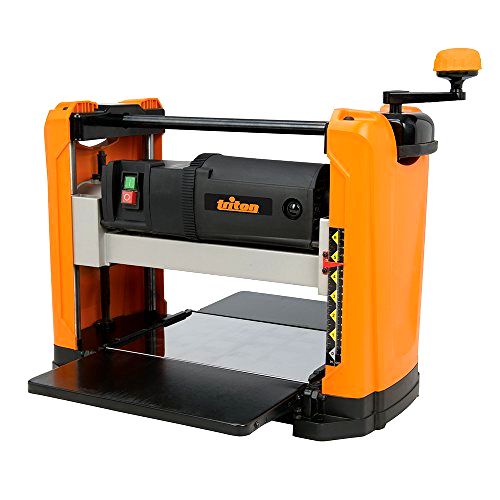
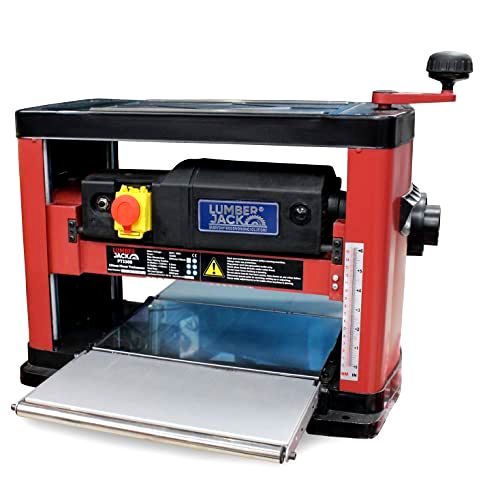
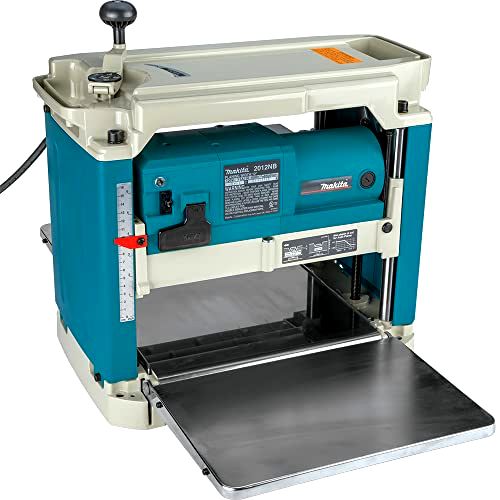
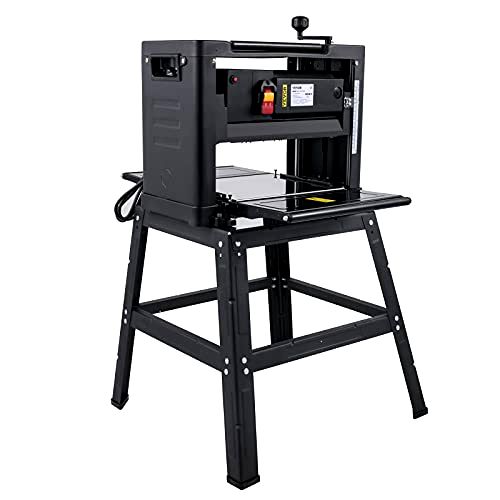
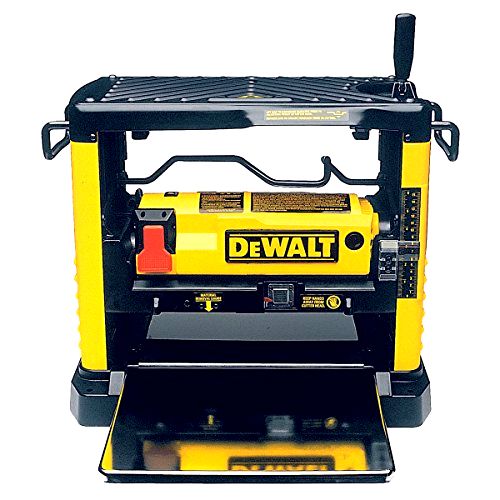
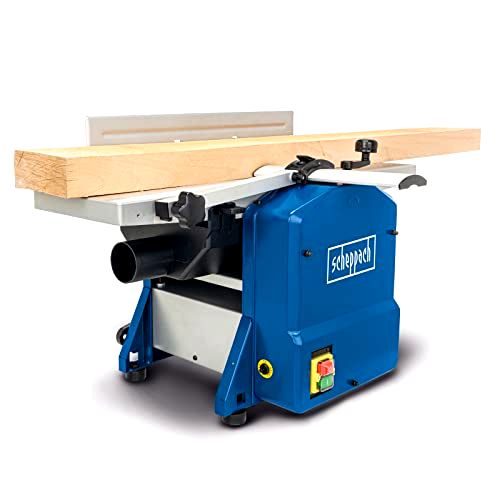
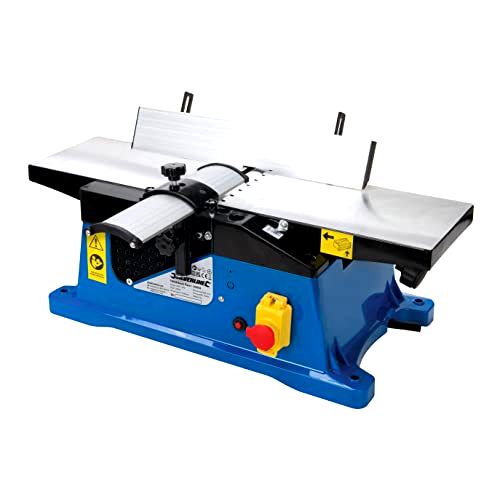

Share